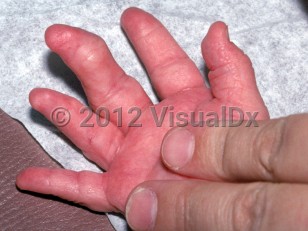Proteus syndrome in Adult
Alerts and Notices
Important News & Links
Synopsis

Proteus syndrome is a hamartomatous disorder characterized by progressive, asymmetrical overgrowth of various tissues, including skin, bone, soft tissue, and internal organs. It is caused by a mosaic activating mutation in AKT1 on chromosome 14. It is extremely rare, with the sexes affected about equally.
A plethora of clinical manifestations accompany Proteus syndrome and are variable between patients. Hemihyperplasia (asymmetric overgrowth of the head, face, digits, or limbs) is usually found. Overgrowth of the cranium, vertebrae, spleen, thymus, or external auditory meatus may occur. The presence of cerebriform connective tissue nevi is a characteristic finding, but these are not always present. Other cutaneous and soft tissue abnormalities include epidermal nevi, vascular malformations, pigmentary changes, and disordered adipose tissue growth leading to either lipomas or lipohypoplasia. Furthermore, a variety of skeletal, visceral, central nervous system (CNS), and ocular abnormalities may be present. Ovarian cystadenomas and parotid monomorphic adenomas are overrepresented in Proteus syndrome patients. A distinctive facial phenotype has been described in patients with intellectual impairment.
Some manifestations are usually present at birth, but this diagnosis may not be suspected until late infancy, depending upon the rate of overgrowth and appearance of skin lesions. Overgrowth progresses through childhood and then stabilizes.
Prognosis depends upon the severity of disease. Complications include respiratory compromise or cord compression from spinal defects, major deformity and disability, and increased risk of venous thrombosis and pulmonary embolism. Most patients have normal intelligence, but some have learning disabilities or seizures.
A plethora of clinical manifestations accompany Proteus syndrome and are variable between patients. Hemihyperplasia (asymmetric overgrowth of the head, face, digits, or limbs) is usually found. Overgrowth of the cranium, vertebrae, spleen, thymus, or external auditory meatus may occur. The presence of cerebriform connective tissue nevi is a characteristic finding, but these are not always present. Other cutaneous and soft tissue abnormalities include epidermal nevi, vascular malformations, pigmentary changes, and disordered adipose tissue growth leading to either lipomas or lipohypoplasia. Furthermore, a variety of skeletal, visceral, central nervous system (CNS), and ocular abnormalities may be present. Ovarian cystadenomas and parotid monomorphic adenomas are overrepresented in Proteus syndrome patients. A distinctive facial phenotype has been described in patients with intellectual impairment.
Some manifestations are usually present at birth, but this diagnosis may not be suspected until late infancy, depending upon the rate of overgrowth and appearance of skin lesions. Overgrowth progresses through childhood and then stabilizes.
Prognosis depends upon the severity of disease. Complications include respiratory compromise or cord compression from spinal defects, major deformity and disability, and increased risk of venous thrombosis and pulmonary embolism. Most patients have normal intelligence, but some have learning disabilities or seizures.
Codes
ICD10CM:
Q87.3 – Congenital malformation syndromes involving early overgrowth
SNOMEDCT:
23150001 – Proteus syndrome
Q87.3 – Congenital malformation syndromes involving early overgrowth
SNOMEDCT:
23150001 – Proteus syndrome
Look For
Subscription Required
Diagnostic Pearls
Subscription Required
Differential Diagnosis & Pitfalls

To perform a comparison, select diagnoses from the classic differential
Subscription Required
Best Tests
Subscription Required
Management Pearls
Subscription Required
Therapy
Subscription Required
References
Subscription Required
Last Reviewed:03/01/2021
Last Updated:03/03/2021
Last Updated:03/03/2021

